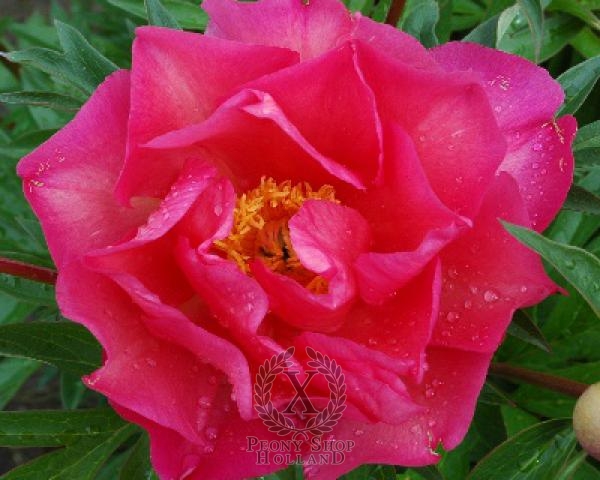Peony Watermelon Wine
| Size | Weight |
|---|---|
| 3/5 eye | 300 gram |
Peony Watermelon Wine is one of the many semi-double watermelon red Itoh Peonies that we grow at Peony Nursery Peony Shop Holland Intersectional peony hybrids, also known as Itoh hybrids, named in honor of Toichi Itoh, the originator of these unique hybrid peonies. They are representative of the progeny of crossing or hybridizing the two main groups or selections of peonies; the herbaceous hybrids which die down sub surface buds during their dormant season and the tree or woody shrub peonies which retain a year round woody branch structure above ground level. During their dormant season, the Itoh or Intersectional hybrids retain only extremely short (1"-2") woody stems above ground level. Ornamentally, they achieve the best of both parental worlds with the handsome flowers and foliage of the woody tree peonies displayed on an herbaceous plant, with annual new growth originating from buds below ground level. Strong healthy plants form attractive dense, neat rounded bushes which are shorter in stature than most tree peonies. Flowers are displayed above the handsome foliage that remains greener longer than their herbaceous parents. Intersectional hybrids are somewhat hardier than tree peonies and more tolerant of heat and humidity which extends their ornamental potential in both the North and south.
About Peony Nursery "Peony Shop Holland Peonyshop.com"
Peony Nursery Peony Shop Holland Peonyshop.com in these days primarily concentrates on improving unique, extraordinary high quality peonies. It hasn't always been this way. This particular organization comes with an outstanding back ground getting started in the year 1875 with Simon Scholten that had been growing vegetables and fruits for an income.
During 2001 the particular business organisation developed their very own new-found advertising and marketing-name & logo design "Peonyshop.com" and they started off focusing on expanding unique peonies. During the year 2002 the particular business launched their own world wide web peonyshop together with Peonies & Buxus. Within the year 2003 Joshua Scholten started out with raising peonies. After that in 2004 this company started to foreign trade peonies of the Netherlands all around European countries, Usa plus Asia.
Nowadays our own peony nursery is specialized in expanding and increasing the number of exclusive, good quality peony roots that can be offered for sale and released in many countries. Furthermore we additionally reduce peonies primarily serving the Dutch peony flower market place.
The things we pride:- The superior quality of our products
- The ability to export world-wide
- All of our broad assortment peonies like Watermelon Wine
- The peony crame of substantial full potential seedlings
About growing Watermelon Wine peony plants
The fall is usually the perfect period if you weigh in mind growing peonies. Nearly all peonies are actually exceptionally long-lived plants staying alive up to 50 to a max of seventy yrs, so once a person get the peonies placed in the right way, an individual will definitely enjoy the plants for years and years. Peonies have a preference for a bright area having a well-drained dirt. A high quality air movement presented around the plant is essential. These environments support these plants to stay away from sickness issues. To organize the seeding hole meant for a bareroot peony plant, dig the dirt to a depth of 12-18inches. Utilize garden tools to release the sides of the planting hole as well. It truly is especially significant that the "eye", or growing nodes, positioned near the bottom of the old stem, end up no more than Two inches beneath the soil surface area.


